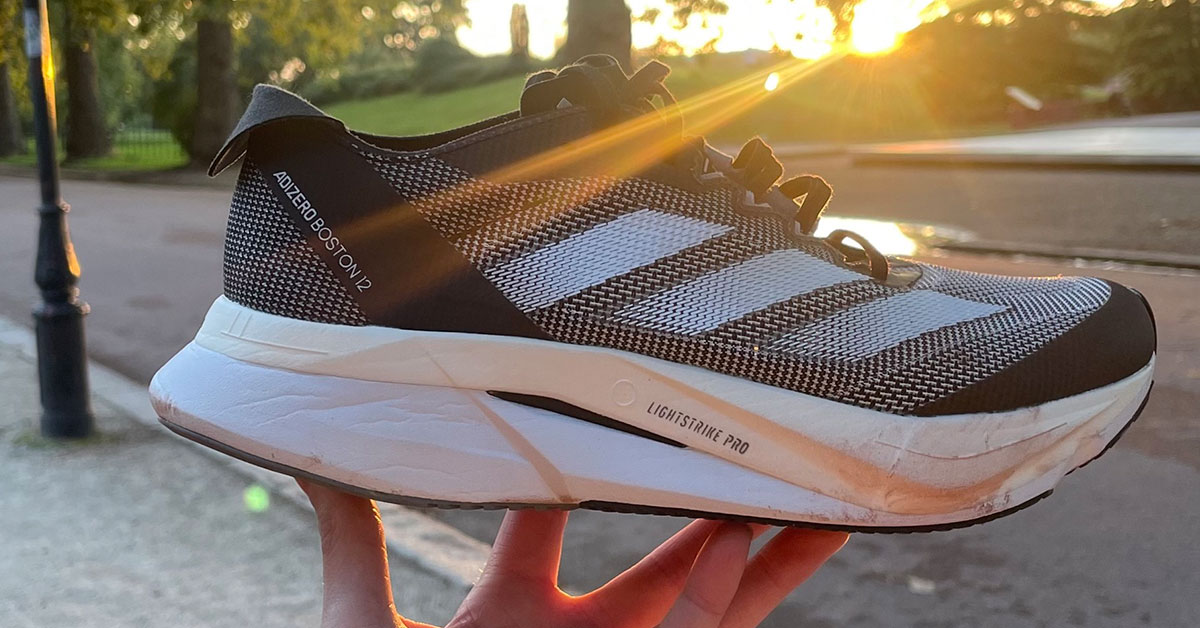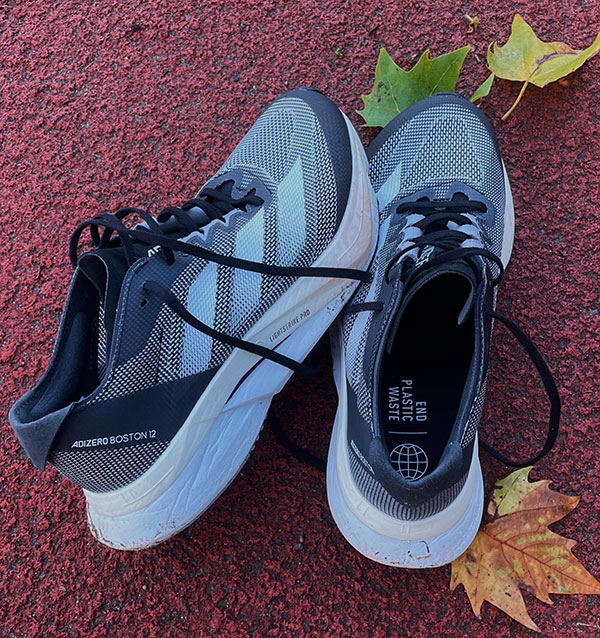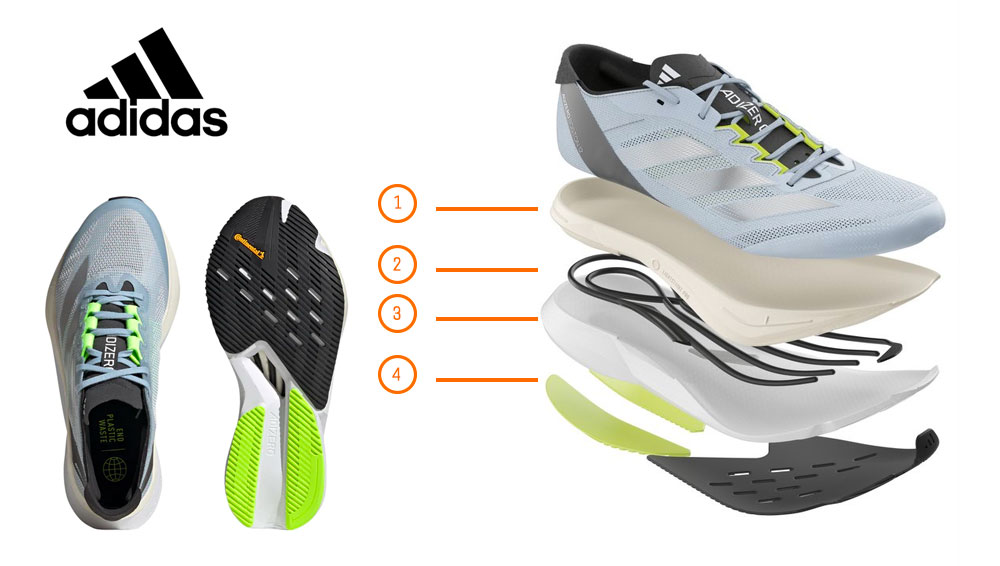Service by appointment only
Call 020 7736 0046
Call 020 7736 0046 To book

This month Profeet team member, Polly, reviews the Adidas Adizero Boston 12
Inspired by Boston Marathon winners since 1982, the Adizero Boston range is designed to take you from tempo pace training sessions to the longer almighty marathons. Though over the past couple of years it has had its highs and its lows, the new Boston 12 is set to make a trusty come back after the 11s.
Having personally missed out on the Boston 9, and going straight to the Boston 10, it was interesting to see the reviews from past wearers expressing their concerns about the different, stiffer fit and feel to the shoe. Being unaware of the change, I wore the 10s for my speed-tempo training sessions and enjoyed their company for just shy of a year. However, when the 11s came out the further alterations to the fit and feel continued to leave most runners disappointed, including myself.

Enter the Adizero Boston 12
This latest, perfect performance-driven shoe seems to have redeemed the Boston’s reputation and earned the satisfaction of runners looking for that lightweight and soft, yet responsive, mid-long distance trainer.
Stats:
Weight: 267g mens 8.5, 227g women’s 7
Stack height: 37mm/30.5mm
Drop: 6.5mm
Classification: uptempo and training
Fitting
The Boston 12’s fitting claims to be true to size, but with a slightly snug fit on the width if you are between sizes, I recommend sizing up half a size. However, if you’re above a D in width, these shoes may be a tight squeeze and the thin upper could pose a risk.
The heel counter of the trainer is not comparable to the 10s or 11s as it is now partially non-existent. With a small amount of padding around the heel, it may leave some people hesitant and wanting a little more when they feel the texture of the upper. Having worn both thin compression socks and thicker, blister-resistance ones, I personally noticed no difference and no irritating heel slippage.
If you struggle with light pronation, there is a varus angle in the rear sole to aid in some lateral stability although I would advise trying out the trainer and having one of our trained technicians assess your gait before purchasing this shoe. With very neutral support, the foot security in the shoe is obtained through its low-volume, clasping the foot through the narrow mid-foot to a classic Adidas fitting fore-foot.
The first thing I noticed putting my foot in was the lacing and instep. The laces are held down by an easy adjustable feature, with the same fabric blending into the internal reinforcement around the mid-foot. With a very thin, free-floating tongue, I felt the laces and doubled-over fabric fairly easily. Once I got running and adjusted the laces the feeling was no longer noticeable. But, if you feel the burden of a high instep I would adopt alternative lacing techniques to relieve any possible pressure on the cuneiform bones.
The upper is an engineered designed mesh allowing good breathability, fitting throughout the whole shoe thus providing decent structure and cannot be felt if wearing good running socks.

Function
- Equipped with the Boston’s ultra-light Lightstrike Pro cushioning and combined with the Lightstrike 2.0 for a dual-density foam, there is a softer, smoother ride off the toe but a durable and sturdy base in the rear with little to no break-in period needed. The shoe is finished with a Continental outsole to provide reliable traction during any condition. The mechanically engineered, and 50% recycled, meshed upper adds to the lightweight feel of the shoe and a secure and sufficient lacing locks the foot down.
- Designed to be a neutral shoe, the structure and support during each stride comes from the Energy Rods built into the sole. The foot is able to perform in a dynamic manner, whilst the full-length rods provide enough stiffness and support to prevent the foot sinking into the foam delivering an appropriate amount of efficient energy return to give that ‘springy’ feeling at toe-off.The updated rods now offer an additional lateral extension, with the aim to drive the mid-foot medially if a heel-striker, or act as a more efficient stabiliser if a lateral mid-foot striker. Providing a higher stack with a varus angle at the heel, it creates a subtle lateral bias as you land comfortably into the stride.
- The 6.5mm heel-toe drop adds to the smooth heel-toe transition, but with the soft Lightstrike Pro material at the forefoot the drop seems greater, even more so with the large fore-foot rocker to assist in the snappy yet smooth ride. However, with the softer forefoot material composition, I found it wasn’t as noticeable unless I upped my speed over a shorter distance, going from a rear-foot to a mid-foot striker – then the snap kicked in.
- Another, more subtle (unless you know where to look) change is the placements of cutouts found in the sole to expose the Energy Rods. Bostons 10 and 11 found the cutout was closer to the fore-foot, whereas the Boston 12s finds the cutout in the mid-foot. This could align with increased potential for medial movement for that dynamic foot function, further classifying this shoe as a true-neutral trainer, as opposed to the 10 and 11 which were stable/neutral trainers.
Recommendations
Biomechanically, over a longer distance the foot will want to work in a more dynamic state. A rigid, stiff shoe is great to prevent the foot collapsing into the foam for a strong, reliable and snappy ride, but can prevent the foot working most efficiently over a long period of time risking tension held in the foot.
The Bostons 12s have a bit of that ‘best of both worlds’: A sturdy Energy Rod function for the quicker interval training session but with sufficient flexibility to allow good foot function during uptempo, more-miles runs.
But, getting two feet into two doors does mean it may be missing a few features. I personally wouldn’t use this as a race shoe as I feel that the snappy, rigid sole response will be missed, but I also wouldn’t use it for my longer, slower, recovery runs, as I prefer more structure around my foot.
If you are following a training plan or are part of a club where speed-intervals or uptempo runs are a common occurrence in training, these shoes will do you nicely.”
If you are fan of this shoe or trust Adidas as a brand for yourself, pairing the Boston 12s with the Adizero Adios Pro 3s for your carbon plated racing shoe will work well. If you are looking for something with less stack height and find the Energy Rods not as stable as you’d like, switching to the Adizero 8s that hold a fairly similar function should be a nice solution.
Alternatively, if you find the Boston 12s not the right fit for you but want a shoe with a similar function, the Brooks Hyperion Max covers the ground. With a similar weight, smooth stride transition and comparable performance outcome with softer and plushier upper.
Conclusion
I love this shoe – a wanting it in every colour kinda love! It is perfect for what I do as a runner and I have found myself integrating it really nicely into my shoe rotation. Having never got on with heavy shoes (and I’m talking about a kicking off heavy, water soaked trainers mid Crag race, to run on sharp stones kinda hate…) these feel lighter than they weigh, and are therefore deceptive in how much they assist you in your training, letting you feel like your legs can just carry you through.
Currently sitting with at least 50km under my belt with these shoes, there is hardly any signs of wear. Most of this distance has been on the track doing 5km interval sessions at tempo and uptempo pace. Feeling safe and secure in my 10s, I was hesitant to change them to a lighter, more neutral shoes. Yet my expectations proved wrong.
The shoe is lighter, the upper is thinner, the fit is forgiving yet secure, the transition is smooth yet snappy and the ride is, well, comfortable.
Check out the range in our online store or call 020 7736 0046 to book our analysis service with custom insoles for a custom-fitted solution.
OUR SERVICE IS BY APPOINTMENT ONLY
Profeet’s services are by appointment only, please call or book online in advance
